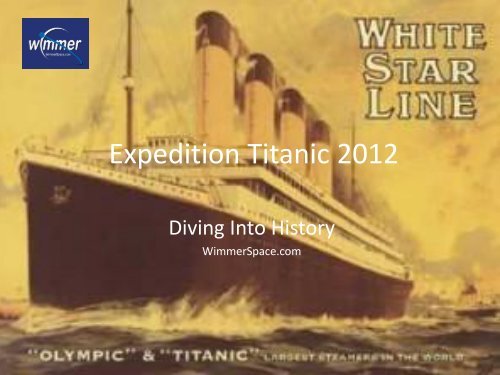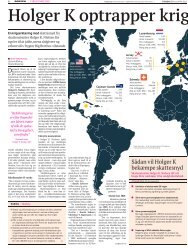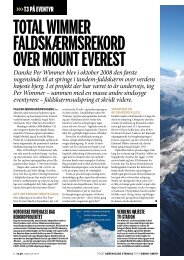Expedition Titanic 2012 - Per Wimmer
Expedition Titanic 2012 - Per Wimmer
Expedition Titanic 2012 - Per Wimmer
You also want an ePaper? Increase the reach of your titles
YUMPU automatically turns print PDFs into web optimized ePapers that Google loves.
<strong>Expedition</strong> <strong>Titanic</strong> <strong>2012</strong><br />
Diving Into History<br />
<strong>Wimmer</strong>Space.com
Historical Background<br />
Maiden Voyage<br />
The <strong>Titanic</strong> began her maiden voyage from Southampton, bound for New York City on 10 April 1912, with Captain Edward J.<br />
Smith in command. When she finally departed for New York, there were a total of 2,223 people aboard.<br />
The Iceberg<br />
On the night of Sunday the 14 April 1912, the moon was visible in the clear sky, the temperature had dropped to near<br />
freezing, and the ocean was calm. Lookout Frederick Fleet was the first to see the fatal iceberg as a small mass one mile<br />
away and he immediately alarmed the bridge. The crew tried in vain to turn the ship, but the <strong>Titanic</strong>’s course altered only<br />
slightly allowing the iceberg to tear open the ship’s side. The Captain ordered for distress signals to be sent and the stewards<br />
began to urge passengers to dress and put on their life vests.<br />
The Sinking<br />
Unfortunately the <strong>Titanic</strong>’s distress signals were never heard. On deck, people were scrambling towards the stern or jumping<br />
overboard in hope of reaching a lifeboat. The ship's stern slowly rose into the air, exposing the propellers and everything<br />
unsecured crashed towards the water. The <strong>Titanic</strong> carried 20 lifeboats with a total capacity of 1,178 people, less than half of<br />
the passengers and crew members on board. The morning of the 15 April 1912 the <strong>Titanic</strong> fell into the depths, resulting in<br />
the deaths of 1,517 people in one of the deadliest peacetime disasters maritime in history.<br />
The Rediscovery of the <strong>Titanic</strong><br />
The rediscovery of the <strong>Titanic</strong> was found by Dr Robert Ballard in 1986. Since then multiple dives have been conducted by<br />
some of the world’s five deep diving submersibles. Every dive collates data, physical samples and records imagery from the<br />
site. The wreck itself continues to host ongoing scientific experiments conducted by world scientists.
Timeline April 14-15, 1912<br />
J.C. Milling telegram April 14: ABANAPAS (All well, calm weather, ship fine, having fun,<br />
good company, nice trip).<br />
April 14, 1912 at 23.40: Fleet & Lee spotted iceberg. Three ring signals.<br />
Time to impact: 35-40 seconds. “That was a narrow shave” Fleet.<br />
Size of hole: 1.1 m2 , allowing 7 T/sec water to enter ship.<br />
April 15, 1912 at 00.05: Captain Smith ordered rescue boats in water after inspection together<br />
with Thomas Andrews. “No general alarm was sounded, no whistle<br />
blown and no systematic warning was given the passengers” (USC).<br />
00.25: Carpathia receives CQD. 10 emergency fireworks lit.<br />
00.45: SOS telegraphed out by Bride. Received by Olympic.<br />
00.45 – 01.55 16 rescue boats put in water (some half empty).<br />
01.55: Lowe (5 th captain) fired gun along every deck to prevent<br />
overcrowding of last rescue boat.<br />
02.05: Last Engelhardtboat lowered into water. Approx 1500 people still<br />
on ship. Orchestra playing. Front deck takes in water.<br />
02.15: Captain Smith relieved telegraphers from duty and returns to die at<br />
ship bridge.<br />
02.20 Front deck sank. Front chimney broke. Back end of ship incl .<br />
3 propellers turned up before sinking.<br />
Total onboard incl. crew (876):2223 persons of which 706 survived (32%).<br />
Skewed: women/children 1 st class 145/156 (92%) vs. men 2 nd class 15/157 (10%).<br />
Source: <strong>Titanic</strong>, Thomas Noergaard Olesen
<strong>Titanic</strong> Facts<br />
Completed and left Harland & Wolff shipyard April 2, 1912.<br />
Length & Width: 269.7 m & 28 m<br />
Power: 50.000 hp<br />
Top speed: 23 knots (42 km/h)<br />
Coal consumption: 25 T/hr total load: 8000 T (5900 Maiden)<br />
Electric cables: 350 km & 10.000 light bulbs<br />
Breaking distance: 800 metre (at 20 knots)<br />
Departed Southampton: April 10, 1912<br />
Beer bottles on board: 15.000<br />
Scandinavian on maiden voyage: 180 (of which 13 Danish).<br />
Notable passengers: Henry Harper (Publisher); John Jacob<br />
Astor (Hotelier); Ben Guggenheim<br />
(Mining).
What Went Wrong<br />
Unfortunate set of coincidences:<br />
1. Warm Gulf Stream much further south in 1912 than normally<br />
2. Exceptionally clear and calm night April 14-15, 1912<br />
=> very difficult to spot wave impact on icebergs.<br />
3. Too high speed in iceberg waters (21 knots). Although standard in 1912,<br />
Schackleton: “You have no right to go at that speed in an ice zone (max 4 knots).<br />
Iceberg spotted by Fleet & Lee at 450 m distance.<br />
4. Regulatory shortfall: Rescue capacity was only 20 rescue boats with max 1178 persons (3560<br />
safety belts).<br />
5. Evacuation process: early rescue boats left half empty (only women & children).<br />
Only 700 seats out of 1178 were used.<br />
6. Distance to nearby vessels and communication issues.<br />
Esp Californian (23.00: Jack Philips to Cyril Evans: “Keep out. I’m working Cape Race”).<br />
Mount Temple: only 11 knots<br />
Carpathia: First to reach survivors<br />
Birma: (Russian OEK) arrived at 07.30 am at wrongly given location.<br />
Found Carpathia at noon.
The <strong>Titanic</strong> Became a Movie Star<br />
The <strong>Titanic</strong> tragedy was made even more legendary in 1997 when James Cameron directed one of<br />
Hollywood's most famous love story's of all time. The relationship between Jack Dawson (Leonardo<br />
DiCaprio) and Rose DeWitt Bukater (Kate Winslet) was the main focus, but many of the other characters<br />
were based on actual <strong>Titanic</strong> passengers. Cameron's inspiration for the film was predicated on his<br />
fascination with shipwrecks, he wanted to convey the emotional message of the tragedy, and felt that a<br />
love story interspersed with the human loss would be essential to achieving this.<br />
Production on the film began in 1995, when Cameron shot footage of the actual <strong>Titanic</strong> wreck on board<br />
the Akademik Keldysh. The Akademik Keldysh is the best deep-diving support vessel in the world and is<br />
the same one used for <strong>Wimmer</strong>’s <strong>Titanic</strong> <strong>Expedition</strong> <strong>2012</strong>.<br />
Production costs for the film amounted to $200 million, making it one of the most expensive movie ever<br />
made. The film won a total of 11 Oscars as well as 76 wins and 48 nominations and after its release in<br />
1997 it became the highest grossing film of all time pulling in over $1.8 billion worldwide.
Motivation For Centennial <strong>Titanic</strong> Dive<br />
1. Adventure motive: From flying to a deep ocean dive<br />
2. <strong>Titanic</strong> most iconic ocean dive site in the world<br />
3. Centennial – 100 years on….<br />
4. Last chance: Dive operations to <strong>Titanic</strong> likely to stop after Centennial<br />
5. Indirectly subsidizing scientific observations and analysis<br />
6. Honor and respect to the descendants of the families affected by remembering<br />
that tragic night.<br />
7
<strong>Titanic</strong> 100 Years Later….<br />
8
Getting there...<br />
Akademik Keldysh<br />
The Akademik Keldysh is the best deep-diving support vessel in the world. Owned and operated by the<br />
Moscow-based P.P Shirshov Institute of Oceanology, its crew of scientists and technicians have worked together<br />
for over 17 years, participating in deep-dive expeditions all over the world. In addition to its many laboratories,<br />
the Keldysh features a library covering underwater archaeology, oceanography and deep-sea exploration.<br />
9
Going Down…<br />
MIR I & II<br />
MIR I and II are deep-diving submersibles capable of reaching ocean depths of 20,000 feet. Housed aboard The mothership Akademik<br />
Keldysh, the two MIR submersibles are two of only six deep-diving vessels available to the world’s scientific community. Constructed of<br />
nickel steel, they are designed to withstand the enormous pressures that exist in the depths of the oceans. Each MIR cabin is a 2.1 m<br />
diameter sphere, accommodating three persons. Air pressure inside the habitat remains at a constant one atmosphere; the air is<br />
recycled in a manner similar to that used onboard a spacecraft. During 10 the dive, there will be a drop in temperature to approx. 12C.
• July 13: Arrive St. John’s, Newfoundland<br />
The <strong>Titanic</strong> <strong>Expedition</strong> <strong>2012</strong><br />
- Dive Itinerary<br />
– Meet the Deep Ocean <strong>Expedition</strong>s team and the other dive participants, orientation and briefing.<br />
• July 14: St. John’s / At Sea<br />
– Board the expedition vessel and set sail on the exciting journey towards the <strong>Titanic</strong> wreck site, lying<br />
in international waters 380 miles to the southeast of Newfoundland.<br />
• July 15: At Sea, en route <strong>Titanic</strong> site<br />
– Explore the extraordinary research ship and prepare for the upcoming 12,500 foot dive to the most<br />
famous shipwreck in the world.<br />
• July 16 -21: Arrival at the <strong>Titanic</strong> site / Dives to the <strong>Titanic</strong> wreck<br />
– The dive to the <strong>Titanic</strong> will be made aboard either the MIR I or MIR II submersibles<br />
– It takes 2.5 hours to reach the ocean floor, 12,500 feet beneath the surface<br />
– During the three to four hours down at the <strong>Titanic</strong> wreck site, the dive will focus on the bow section,<br />
the largest and most impressive section of the wreck, numerous artifacts strewn across on the ocean<br />
floor, as well as the ship’s giant boilers, enormous propellers and the famous grand staircase.<br />
• July 22: Departing the <strong>Titanic</strong> site<br />
– Final day at the <strong>Titanic</strong> wreck site<br />
• July 23: En route St. John’s Newfoundland<br />
– A day at sea and a day of reflecting on the incredible diving achievement<br />
• July 24: Arrival St. John’s Newfoundland and Disembarkation<br />
– End of this amazing journey
<strong>Titanic</strong> And Nearby Vessels April 15, 1912<br />
Source: <strong>Titanic</strong>, Thomas Noergaard Olesen
The <strong>Titanic</strong> <strong>Expedition</strong> <strong>2012</strong><br />
- The <strong>Expedition</strong> Team<br />
• <strong>Per</strong> <strong>Wimmer</strong><br />
• Founder of <strong>Wimmer</strong> Financial and <strong>Wimmer</strong> Space<br />
• Entrepreneur, Adventurer, Author, Pioneer<br />
Scheduled to be the first Dane in space. In 2008 he<br />
completed the first tandem sky dive over Mount Everest.<br />
Rob McCallum<br />
General Manager (DOE), Professional expedition<br />
leader. Member of the Explorers Club<br />
About Deep Ocean <strong>Expedition</strong>s<br />
Mike McDowell<br />
• Deep Ocean <strong>Expedition</strong>s (DOE) was founded<br />
in 1998 by Australian diver, climber and<br />
adventurer Mike McDowell along with several<br />
colleagues<br />
Don Walsh<br />
• Retired Navy Captain, submarine commander, Oceanographer,<br />
Professor of Ocean Engineering,<br />
Author, Lecturer, President of Explorers Club<br />
Additional 10-15 adventurers will participate in the <strong>Expedition</strong><br />
Deep Ocean <strong>Expedition</strong>s adheres to three simple founding principles:<br />
• To offer unique experiences for the adventurer<br />
• To educate people about the world’s deep oceans<br />
• To help support scientific research<br />
Deep Ocean <strong>Expedition</strong>s is interested in educating by adventure. Only a small percentage of the world’s oceans have been explored.<br />
Deep Ocean <strong>Expedition</strong>s works with partners and colleagues, including the PP Shirshov Institue, to expand opportunities for deep<br />
ocean research and documentations as a way of increasing the knowledge and understanding of our planets’ major geographical<br />
feature. All submersible dives are conducted with negligible or no impact on our oceans. All sites, whether they be manmade or<br />
natural, are treated with the greatest of respect.
<strong>Titanic</strong> Deck<br />
14
<strong>Titanic</strong> Doors<br />
15
16<br />
Never Forget…
Motivation For <strong>Per</strong> <strong>Wimmer</strong><br />
<strong>Per</strong> <strong>Wimmer</strong> is a global financier, author, entrepreneur, adventurer, a pioneer and a philanthropist - or, as a<br />
commentator has argued, a true "Indiana Jones meets 007 James Bond.“<br />
Mankind exists in a human sphere that expands 10 km up in the air and 1 km below the sea surface. Within this<br />
span people’s comfort zone lies. However, <strong>Per</strong> likes to push these boundaries and is doing so by flying into space<br />
(min 100 km) and now diving down to the <strong>Titanic</strong> wreck 3.8 km under sea level.<br />
<strong>Per</strong> <strong>Wimmer</strong>'s story is about making dreams reality. Turning into reality what appears to be a far-fetched vision<br />
which few people consider achievable. <strong>Per</strong> is scheduled to become the first Dane in space and currently holds<br />
three space flight reservations. On Oct 6, 2008, <strong>Per</strong> <strong>Wimmer</strong> made world history, together with Ralph Mitchell, by<br />
successfully completing the first tandem sky dive over the highest point on earth, Mount Everest. This adventure,<br />
"Everest from the top," had never been done before and pushing the boundaries, being a pioneer is, indeed, part<br />
of what drives him..<br />
Adventure travelling has taken him to more then 60 countries on earth and with this new adventure <strong>Per</strong> will be<br />
exploring a world few people have seen. To explore one of the worlds most iconic shipwrecks, to learn more about<br />
the tragic day 100 years ago and to honour and respect the families affected by the tragic night, will be a once in a<br />
lifetime experience. Furthermore, dive expeditions to the <strong>Titanic</strong> wreck site are likely to stop after the Centennial<br />
which makes this perhaps the last chances to experience this majestic site.
<strong>Wimmer</strong> Space<br />
3-5 Swallow Place<br />
London W1B 2AF, UK.<br />
Tel. (+44) 778.875. 7677<br />
Tel. (+44) 207.432.7513<br />
Email: info@<strong>Wimmer</strong>Space.com.<br />
Web: www.<strong>Wimmer</strong>Space.com<br />
Contact Information







